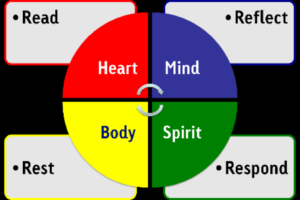Lectio Divina:
Latin for the divine reading of Scripture…
Scripture heals and transforms from the mind down into your heart.
Recently I posted a blog with a list of poll results, that answered the question: what do Moms do for stress management. The responses were real and raw. And, as I mentioned then, while some may have been said in jest — they are likely the most truthful and/or wishful-thinking.
One response that came up several times, in one form or another was prayer and I would have to agree.
I did a short small group study in Lectio Divina or divine reading and found it meditative. Here is what we worked with:
Pick a passage:
Pick a passage of your choosing. It shouldn’t be too long. A couple we worked with included:
Ephesians 3:14-21
Ephesian 4:1-6
Genesis 32:22-31
Mark 2:1-11
Mark 4:35-41
Isaiah 40:25-31
Philippians 2:1-11
Matthew 13:44-46
Prepare yourself:
In our group, we would prepare ourselves to become aware of God’s presence. This was done through prayer and deep breaths – a simple silencio, breath prayer:
“Loving God” (breath in) “Speak to my heart” (breath out)
“Come Holy Spirit” (breath in) “I am listening” (breath out)
“Jesus” (breath in) “Be the center” (breath out)
Four Steps in Lectio Devina:
One method of Lectio Devina is to do four readings. One to focus on each of Guigo’s four steps. In Latin Guigo’s divine reading steps are lectio (reading), meditatio (mediation), oratio (prayer), and contemplatio (contemplation).
You can use four R’s to remember the four steps as read, reflect, respond, and rest.

Step 1. Read the passage slowly and outload if possible. Avoid analyzing and simply try to savor the words, letting them sink in. Listen for nudge. What words stick out to you. What images do you see? What character in the story do you identify with?
For our small group, one person would read the passage, we would let it resonate for a few moments and then call out the word or image we were drawn to.
Step 2. Reflect. Re-read the passage. You may linger over the word or phrase or person that you were drawn to. Consider your feelings. What emotions are being evoked. How is this passage speaking to you and a specific situation in your life today?
A second person from our small group would re-read the passage. Hearing the spoken Word from another’s voice resonates differently. After a few moments we could share a phrase or situation the passage’s meaning brought to us.
Step 3. Respond. You may read through the passage a final time and allow the Scripture to lead you into a prayer response. This is your opportunity to talk to God about what has come to mind, what you are being called to do in your life and how you will respond.
During this time, we may share as a group something that is going on in our life and our plan for the upcoming week or a lesson learned or a hope moving forward.
Step 4. Rest. Contemplation allows us to rest in the awareness of God’s presence. It is time to simply be still. Expect nothing. Enjoy a moment of fellowship with God that is deeper than words. Relax in this moment to be and know that you are loved.
If you are curious about this, but just aren’t sure where you would start – yes, there is an app.
~Malissa
[gravityform id=”10″ title=”true” description=”true” ajax=”false”][/gravityform]

